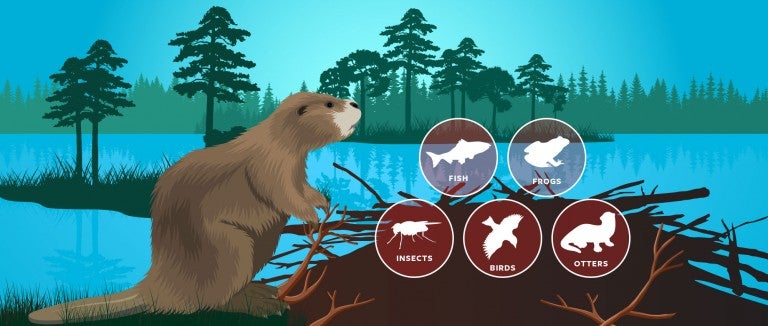Leading a summer camp class about beavers, Tabby Fique hoped for a glimpse of her favorite furry hydrologists. But another wildlife sighting offered an even better teachable moment.
“We were looking at the pool created by the beavers, and a muskrat swam by!” recalls Fique, the land manager for the Howard County Conservancy, a historic farm and preserve in Maryland. “It’s the first time I’ve ever seen a muskrat here, and I’ve worked here a long time.”
The new inhabitant was proof of beavers’ ability to welcome back wildlife, from butterflies and birds to frogs and otters. Not long ago, Fique was more likely to find human artifacts in the stream: basketballs, picture frames, an Etch A Sketch. Without beaver dams to slow rushing waters, the rainstorm-swollen stream swept benches from banks and a bridge off its foundation.
That was before the county joined a growing number of jurisdictions in righting ecological wrongs that started four centuries ago, when fur traders decimated beaver populations for hats. In 2017, a restoration project reconnected the stream and floodplain, making the area beaver-friendly and creating an “amphibian paradise,” says Fique, with “more tadpoles than you could shake a stick at.”
Before European arrival, up to 400 million beavers built a boundless network of wetlands that hosted countless species across the continent. “Our streams don’t look anything like they used to,” says Scott McGill, whose company, Ecotone, helped repair the Conservancy stream. By studying soil layers and early survey maps, McGill paints a picture of a region dominated by beaver-sculpted waterways. He now thinks of the talented rodents as partners. Without beavers, he says, “maybe it’s not even restoration at all.”
Exacerbating beavers’ longtime disappearance from the landscape, centuries of deforestation, agricultural ditching and mill dams led to erosion and sedimentation. The nation’s fast-flowing, deeply incised tributaries flood in rains and dry out in droughts. They only look normal to us because of our “ecological amnesia,” a phrase invoked by a Washington state biologist who was surprised to discover beavers helping juvenile salmon in tidal wetlands, where small dams create shallow pools among dense shrubs that are all but inaccessible to hungry herons. It’s not just that we don’t appreciate such positive contributions, writes Frances Backhouse in Once They Were Hats: “It’s a more serious matter of completely forgetting what we had and why it mattered.”
As scientists remedy that knowledge deficit, they’re recruiting beavers as “field medics” in wounded landscapes, sometimes relocating them from spots where they would otherwise be killed to places where their efforts can restore bird habitat, filter pollutants, recharge groundwater, slow wildfires and possibly even mitigate effects of climate change, writes Ben Goldfarb in Eager: The Surprising Secret Life of Beavers and Why They Matter. Though dams sometimes wreak havoc locally, Goldfarb suggests looking “beyond your backyards, and you’ll see that beavers have a well-documented ability to abate, absorb, and attenuate floods at a vast scale.”
For those whose beaver-flooded basements leave them more irritated than impressed, experts like Mike Callahan of Beaver Solutions can help. He has installed hundreds of flow devices in Massachusetts that prevent flooding while keeping beavers happy. His 95% success rate—at almost half the cost of trapping—puts him in demand, so he trains others through his nonprofit, the Beaver Institute.
In March, Callahan and McGill are hosting BeaverCON, featuring HSUS staff and other experts. They’ll encourage attendees to “think like a beaver”—not so difficult given our species’ similarities: Beavers mate for life, and yearlings help care for kits. They clean and repair their lodges. And they alter landscapes to their liking, though in a profoundly healthier way. Humans would do well to mimic beavers’ restorative powers—starting by leaving them more space to call home.
Want more content like this?
This was written and produced by the team behind All Animals, our award-winning magazine. Each issue is packed with inspiring stories about how we are changing the world for animals together.
Learn MoreSubscribe
